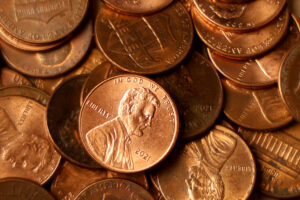- Slug: Penny Trump Copper. 660 words.
- Photos available.
By Matthew DeWees
Cronkite News
WASHINGTON – Most copper mined in the U.S. comes from Arizona. But President Donald Trump’s surprise announcement that he will halt production of pennies won’t make a dent in the state’s mining industry.
The U.S. Mint produced 3.2 billion pennies last year. But since 1982, nearly all of the metal used has been zinc.
So the copper industry can shrug off Trump’s move, which economists have long called a no-brainer because each penny costs more to make than it’s worth – 3.69 cents as of last year – and most end up in jars, piggy banks and sofa cushions.
“The penny is kind of an American institution, and it’s special in Arizona because we mine 70% of American copper,” said Kray Luxbacher, head of the Department of Mining and Geological Engineering at the University of Arizona.
But she said, “From an economic perspective, if you make a product that costs more to make than it’s worth, that’s a problem.”
The cost of producing a penny has far exceeded the value of each coin for the past 19 years, according to the U.S. Mint, which is part of the Department of Treasury.
A penny weighs 2.5 grams. Only a tiny fraction is copper – 2.5% by weight. The rest is zinc. Most refined zinc used in the United States is imported from Canada.
The 3.2 billion pennies minted in 2024 have a face value of $32 million and cost the government – and taxpayers – about $118 million to make.
Only about $1.8 million worth of copper went into those pennies – 198 metric tons at an average cost of $8,889, according to the Mint.
That’s about 0.02% of annual U.S. copper production.
So even if the penny is eliminated, Luxbacher said, “I don’t think that it will change the price substantially.”
Arizona is known as the Copper State. The large copper star at the center of the state flag represents its copper industry.
Trump posted Sunday night on Truth Social that he has instructed his new Treasury secretary, Scott Bessent, “to stop producing new pennies.”
“This is so wasteful!” he wrote. “For far too long the United States has minted pennies which literally cost us more than 2 cents.”
It is unclear whether the president or the Treasury secretary has the authority to halt the minting of pennies.
Last September, The New York Times quoted Edmund Moy, director of the Mint from 2006 to 2011, recalling a request to Congress for authority to end production of pennies: “I said, ‘You guys need to pass a law forcing me to change it.’”
The last time the Mint stopped producing a coin was in 1933 when it stopped making the gold eagle ($10) and double eagle ($20). Production of a half-cent coin stopped in 1857.
Despite the state’s leading role in copper production, some Arizona lawmakers have advocated for phasing out the penny.
In 1989, Jim Kolbe, a Republican who represented southern Arizona in Congress, introduced the Price Rounding Act. The bill would have required cash transactions to be rounded to the nearest nickel. Pennies would only be acceptable in quantities divisible by five, as well. Kolbe died in 2022.
In 2017, the year before his death, Republican Sen. John McCain introduced the Currency Optimization, Innovation, and National Savings (COINS) Act. The bill would have suspended production of pennies for 10 years. It didn’t get to the floor.
Canada, Australia and New Zealand have stopped circulating their one-cent coins, according to a 2022 Congressional Research Service report.
Resistance to eliminating the penny has stemmed in part from concern that consumers will overpay when transactions are rounded to the nearest nickel.
“Without the penny, the demand for nickels would rise to fill the gap in small-value transactions,” according to Americans for Common Cents, a pro-penny group backed Artazn – which sells zinc blanks that the U.S. Mint turns into pennies.
As the group points out, nickels are no bargain for taxpayers, either.
“Since each nickel costs nearly 14 cents to produce, this shift would drive up overall production expenses for the government,” the group argues.
For more stories from Cronkite News, visit cronkitenews.azpbs.org.
